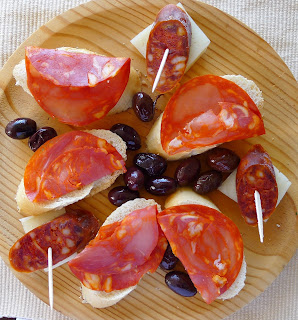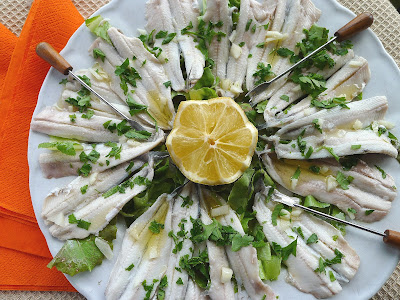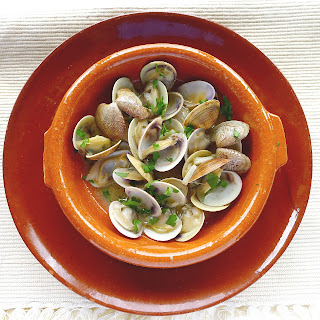Did you celebrate World Tapas Day? That was June 16 (third Thursday of June), declared by Turespaña to promote Spanish gastronomy. Restaurants and taverns all over the globe have joined in the celebrations of Spanish tapas. Since there’s no expiration date on tapas, we can celebrate today and next week just as well.
 |
| A Málaga tapas bar. |
So, what are tapas, anyway?
In Britain and America tapas are usually interpreted as small-plate dining, a series of dishes to be shared at the table. But, on home ground, in Spain, tapas are not really an alternative way of dining. For one thing, you might never sit at a table to have tapas. You stand at the bar or at little side tables, a window ledge, an upended barrel, any place to set a wine glass and small plate. And, you may or may not consume a quantity of tapas that adds up to a whole meal.
 |
| Pinxtos in Bilbao. |
The
tapeo is a movable feast--you stop at one bar to taste its specialty, then stroll up the street to another, around the corner for a third round. When you bump into another group of friends, you move on to a different locale. Part of the attraction of the tapeo is the
paseo, stroll, and the
movida, the action, the buzz. The movement is part of the entertainment.
Going out for tapas is a social event, so you need a little gang, a
cuadrilla, of three, four or five people, for a proper tapas crawl. Each pays for a round of drinks and tapas. You may order a second round or move on to another bar.
Many bars serve a complimentary tapa—a few olives, a golden croquette, a meatball—with every glass of wine or beer. But then you order from a list of tapas and pay for them accordingly. In some bars, the list is chalked on a board; in others the waiter spiels off in rapid-fire the
pregón, or selection. If you don’t catch the recitation, press your way up to the bar and have a look at the platters of food on display.
 |
| Bar guy lists the tapas. |
A tapa is a small, individual portion, really just a bite or two, not meant to be shared. But the list of specialties may be offered in three sizes (and three prices)—tapa,
media ración (half plate) and
ración (whole plate).
In Spain, it’s part of the tapas way of life to stop in a tapas bar on your way home for lunch or dinner and have a
vinito, a little glass of wine, or
cañita, a short beer, with just one small tapa taste. However, if you go out with some friends with the plan of stopping in several bars, then you’re
de tapeo, on a tapas crawl. Over the course of an evening, tapas and accompanying drinks add up to supper. In the Basque Country, the tapeo is
ir de pintxos, to go for
pintxos, which is the Basque word for small-bite foods stuck on picks.
 |
| Ir de pintxos in the Basque Country. |
Bar-hopping is
el copeo, chiquiteo, chateo or poteo, terms derived from different words for a wine glass. In Galicia, it’s
tomar una taza, to have a “cuppa”, because wine used to be served in small, white porcelain cups.
Where can you expect to sample tapas? Many tapa bars are like your local friendly neighborhood pub, where you might stop off for a
copa, enjoy a few bites of local sausage, listen to the evening news or stay on for the football game.
Bar means a bar or pub, while a
barra is the actual bar-top, of wood, zinc, stainless steel or tile, where the tapas are displayed.
 |
| This Madrid bar features Spanish ham. |
In addition to bars, you can go for tapas to a
taberna or
tasca (both words for tavern), a
bodega (barrel room or wine cellar), a
cervecería (beer bar), a
sidrería or
chigre (cider house), a
champañería (where
cava or Champagne is served), a
marisquería (where shellfish is served), a
freiduría (fry shop), a
mesón or restaurant that also has a bar. A wine bar,
vinoteca, probably serves tapas, usually paired with wine selections, but a
bar de copas, cocktail bar, does not. Many cafés morph into tapa bars once the breakfast trade is finished.
So, what’s for tapas? The variety is stunning. You can sample lots of flavors without eating large quantities of food, so they make a great introduction to Spanish food. You can choose foods in any order you like, eat meat and fish in any combination.
 |
| Tortilla--eggs and potato omelette--is Spain's favorite tapa. |
 |
| Order a tabla, board, of sliced sausages and ham. |
 |
| A classic--gambas al ajillo--sizzling shrimp. |
 |
| Tigres--"tigers--" are mussels in sauce served in their shells. (Recipe below.) |
 |
| Patatas bravas--fried potatoes with spicy sauce--a Madrid favorite. |
 |
| Bacalao pil pil, cod in a garlic sauce. |
 |
| Basque pintxos--the Gilda. |
 |
| Cheeky quail eggs and ham on toasts. |
 |
| Always olives. |
 |
| Batter-fried shrimp (en gabardinas). |
 |
| Marinated fresh anchovies. |
 |
| Clams marinera. |
Tapa bars serve from 10 to 50 different dishes, although some specialize in variations on a single theme. So, a particular bar may serve only ham and sausages; another, only
bacalao (salt cod) dishes; others, exclusively shellfish, or snails.
Tapas in Spain range from very traditional home cooking to the innovative and trendy. The small-bites concept provides chefs a showcase for their latest culinary creations and allows diners to sample a wide range of dishes—a sort of tasting menu—without spending a lot of money.
Tapas are not necessarily finger-food, as some stews and sauced foods may require a spoon or fork plus bread for mopping up delicious sauces. But you should be able to eat them standing up, with just one hand.
 |
| Meatballs in almond sauce. |
 |
| Salpicón--shellfish cocktail. |
The tapas experience is not just about the food and drink. It’s about conviviality.
When the weather is fine, the tapa scene spills outdoors and becomes part of street life. Some bars place high, stand-up tables on the pavement. You get your wine and plates of food at the bar, then regroup outside. What a good place to see and be seen, to keep an eye on who’s coming and going!
Tapas have their pace, which is leisurely. Spaniards can put away quite a lot of food while just standing at the bar, sipping wine and having an animated conversation with friends. In Spain, tapas are a way of life.
Tigres
“Tigers” (Stuffed Mussels)
 |
| Fried crisp, the stuffed mussels are creamy on the inside. |
These “tigers” are from Madrid--chopped mussels with a béchamel sauce, fried in their shells until the tops are golden. But, who knows why they are called “tigers” in tapa bars? In Santiago de Compostela in Galicia, tigres rabiosos are also mussels, but those “tigers” are cooked in a spicy tomato sauce
Makes 14 to18 pieces.
2 pounds mussels (about 2 dozen), scrubbed and beards removed
2/3 cup water
2 tablespoons olive oil
1 tablespoon finely chopped onion
2 tablespoons flour
¼ cup white wine
½ cup mussel liquid
¼ teaspoon hot pimentón (paprika)
1 tablespoon chopped parsley
1 egg beaten with 1 tablespoon water
½ cup fine dry bread crumbs
½ cup olive oil for frying
Put the cleaned mussels in a deep pan with the water. Cover the pan and shake over high heat until mussels open. Remove from heat and discard any mussels that do not open.
When mussels are cool enough to handle, remove the mussel meat from the shells and chop it. Save 18 of the shells. Strain the mussel liquid and reserve it.
Heat the oil in a saucepan and sauté the onion until it is softened, without letting it brown. Stir in the flour, cook for a minute, stirring, then whisk in the wine and 1/2 cup of the mussel liquid. Cook, stirring, until the mixture is thickened and smooth. Stir in the chopped mussels, the pimentón and the parsley.
 |
| Fill shells with mussels in sauce. |
Put a spoonful of this sauce onto each mussel shell and smooth it level with the top of the shell. Place the filled shells on a tray in a single layer and refrigerate until the sauce is firmly set, at least one hour.
 |
| Dip in egg, breadcrumbs. |
Place the beaten egg and the bread crumbs in two shallow bowls. Dip the mussels, open face down, first into egg, then bread crumbs. Arrange them on a tray in a single layer. (The mussels can be prepared up to this point, then frozen. Freeze them in one layer, then pack them carefully in a freezer bag or plastic container. Let them thaw one hour before continuing with the preparation.) Otherwise, fry them immediately before serving.
To fry the mussels, heat enough oil to cover the bottom of a frying pan. Fry them in two or three batches, breaded side down, until golden brown. Drain briefly on paper towel and serve hot.






































